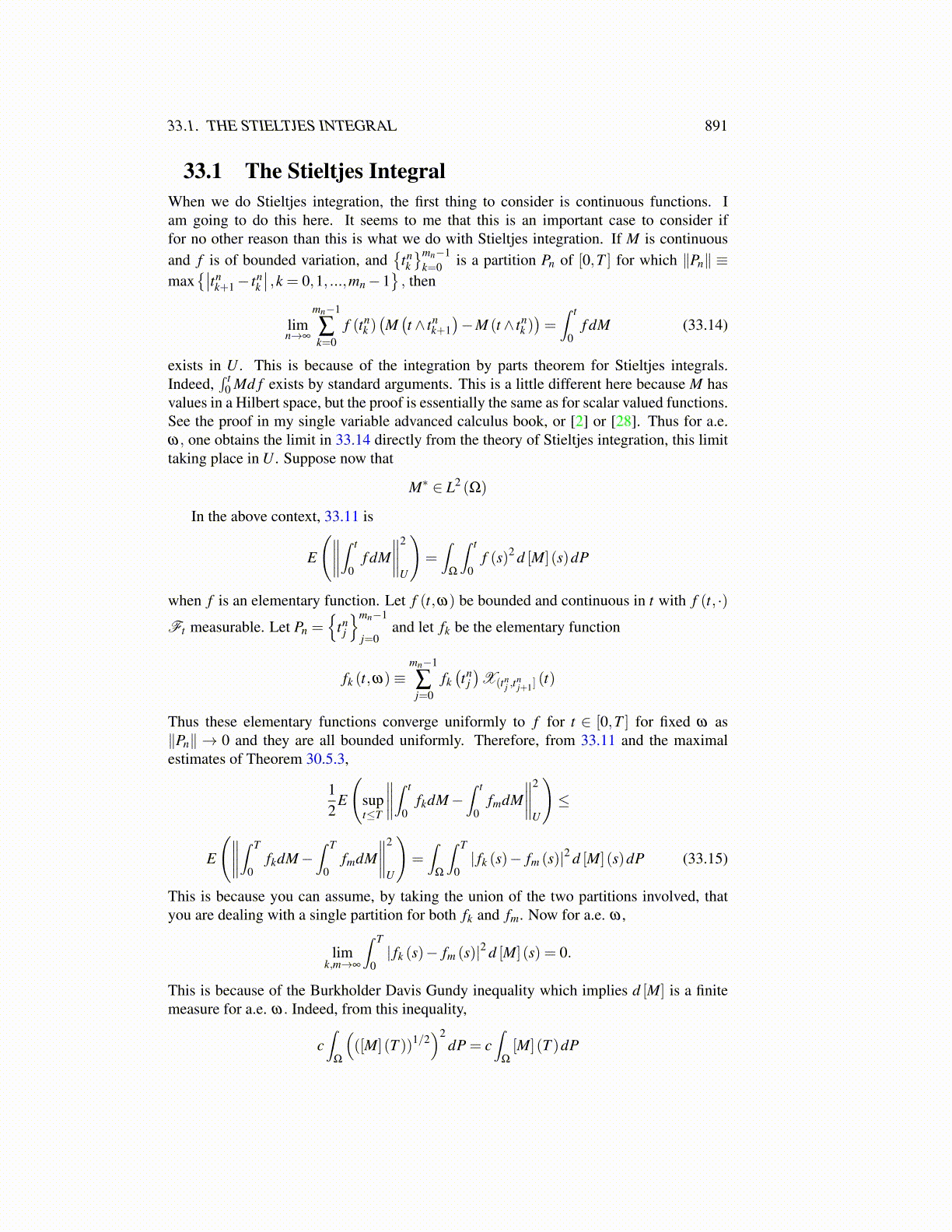
33.1. THE STIELTJES INTEGRAL 891
33.1 The Stieltjes IntegralWhen we do Stieltjes integration, the first thing to consider is continuous functions. Iam going to do this here. It seems to me that this is an important case to consider iffor no other reason than this is what we do with Stieltjes integration. If M is continuousand f is of bounded variation, and
{tnk
}mn−1k=0 is a partition Pn of [0,T ] for which ∥Pn∥ ≡
max{∣∣tn
k+1− tnk
∣∣ ,k = 0,1, ...,mn−1}, then
limn→∞
mn−1
∑k=0
f (tnk )(M(t ∧ tn
k+1)−M (t ∧ tn
k ))=∫ t
0f dM (33.14)
exists in U . This is because of the integration by parts theorem for Stieltjes integrals.Indeed,
∫ t0 Md f exists by standard arguments. This is a little different here because M has
values in a Hilbert space, but the proof is essentially the same as for scalar valued functions.See the proof in my single variable advanced calculus book, or [2] or [28]. Thus for a.e.ω, one obtains the limit in 33.14 directly from the theory of Stieltjes integration, this limittaking place in U . Suppose now that
M∗ ∈ L2 (Ω)
In the above context, 33.11 is
E
(∥∥∥∥∫ t
0f dM
∥∥∥∥2
U
)=∫
Ω
∫ t
0f (s)2 d [M] (s)dP
when f is an elementary function. Let f (t,ω) be bounded and continuous in t with f (t, ·)
Ft measurable. Let Pn ={
tnj
}mn−1
j=0and let fk be the elementary function
fk (t,ω)≡mn−1
∑j=0
fk(tn
j)X(tn
j ,tnj+1]
(t)
Thus these elementary functions converge uniformly to f for t ∈ [0,T ] for fixed ω as∥Pn∥ → 0 and they are all bounded uniformly. Therefore, from 33.11 and the maximalestimates of Theorem 30.5.3,
12
E
(supt≤T
∥∥∥∥∫ t
0fkdM−
∫ t
0fmdM
∥∥∥∥2
U
)≤
E
(∥∥∥∥∫ T
0fkdM−
∫ T
0fmdM
∥∥∥∥2
U
)=∫
Ω
∫ T
0| fk (s)− fm (s)|2 d [M] (s)dP (33.15)
This is because you can assume, by taking the union of the two partitions involved, thatyou are dealing with a single partition for both fk and fm. Now for a.e. ω ,
limk,m→∞
∫ T
0| fk (s)− fm (s)|2 d [M] (s) = 0.
This is because of the Burkholder Davis Gundy inequality which implies d [M] is a finitemeasure for a.e. ω. Indeed, from this inequality,
c∫
Ω
(([M] (T ))1/2
)2dP = c
∫Ω
[M] (T )dP